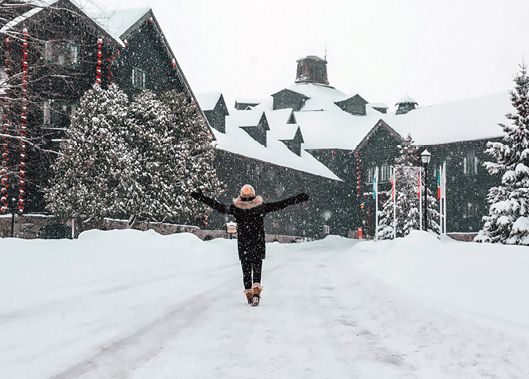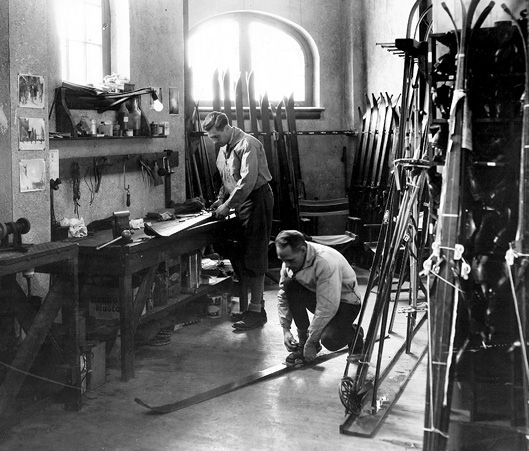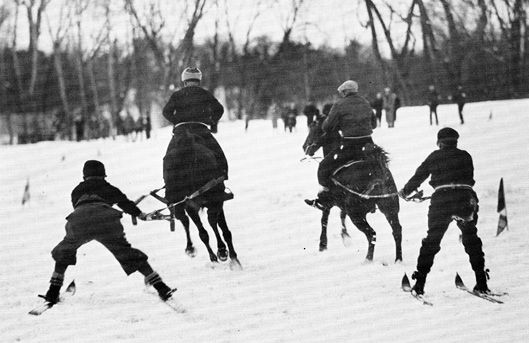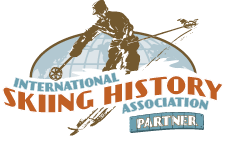
SKIING HISTORY
Editor Kathleen James
Art Director Edna Baker
Contributing Editor Greg Ditrinco
ISHA Website Editor Seth Masia
Editorial Board
Seth Masia, Chairman
John Allen, Andy Bigford, John Caldwell, Jeremy Davis, Kirby Gilbert, Paul Hooge, Jeff Leich, Bob Soden, Ingrid Wicken
Founding Editors
Morten Lund, Glenn Parkinson
To preserve skiing history and to increase awareness of the sport’s heritage
ISHA Founder
Mason Beekley, 1927–2001
ISHA Board of Directors
John Fry (1930-2020), Chairman
Seth Masia, President
Wini Jones, Vice President
Jeff Blumenfeld, Vice President
John McMurtry, Vice President
Chan Morgan, Treasurer
Einar Sunde, Secretary
Richard Allen, Skip Beitzel, Michael Calderone, Christin Cooper, Art Currier, Dick Cutler, Chris Diamond, David Ingemie, Rick Moulton, Wilbur Rice, Charles Sanders, Bob Soden (Canada)
Presidential Circle
Christin Cooper, Billy Kidd, Jean-Claude Killy, Bode Miller, Doug Pfeiffer, Penny Pitou, Nancy Greene Raine
Business & Events Manager
Kathe Dillmann
P.O. Box 1064
Manchester Center VT 05255
(802) 362-1667
kathe@skiinghistory.org
Membership Services
Laurie Glover
(802) 375-1105
laurie@skiinghistory.org
Corporate Sponsorships
Peter Kirkpatrick
(541) 944-3095
peterk10950@gmail.com
Bimonthly journal and official publication of the International Skiing History Association (ISHA)
Partners: U.S. Ski and Snowboard Hall of Fame | Canadian Ski Museum and Hall of Fame
Alf Engen Ski Museum | North American Snowsports Journalists Association | Swiss Academic Ski Club
Skiing History (USPS No. 16-201, ISSN: 23293659) is published bimonthly by the International Skiing History Association, P.O. Box 1064, Manchester Center, VT 05255.
Periodicals postage paid at Manchester Center, VT and at additional mailing offices. Postmaster: Send address changes to ISHA, P.O. Box 1064, Manchester Center, VT 05255
ISHA is a 501(c)(3) public charity. EIN: 06-1347398
Written permission from the editor is required to reproduce, in any manner, the contents of Skiing History, either in full or in part.
Canada's Forgotten Ski Center
 When it opened in 1930, the Seigniory Club was the largest ski resort in Canada...and possibly in North America.
When it opened in 1930, the Seigniory Club was the largest ski resort in Canada...and possibly in North America.
Photo above: Aerial photo of the Fairmont Le Château Montebello resort, on the north bank of the St. Lawrence River in western Quebec, highlighting the Log Château (main lodge) near the waterfront. Though it’s no longer a premier ski destination, winter guests at the luxury resort can still enjoy an extensive network of cross-country trails, snowshoeing, skating, tubing and sleigh rides.

The historic Le Château Montebello, 50 miles east of Ottawa in the Outaouais region of western Quebec, claims to be the largest log structure in the world. That may or may not be true. But while the architecture is impressive, the almost-forgotten ski history of the
hotel is legendary.
Extensive research by the late Pierre Dumas, a retired engineer who won an ISHA Award for his work in identifying and cataloging every ski area and jump in the history of Quebec (Skiing History, July-August 2017), has revealed that when it opened in 1930 the Seigniory Club, as the complex was then called, was the largest ski and winter sports resort in Canada...and possibly in North America.
First, a bit of background. In 1929, a Swiss-American businessman, Harold M. Saddlemire, met the auction price and bought the rural property—a seigneurial estate originally granted in 1674—near the village of Montebello on the Ottawa River. Saddlemire, a bold man with a vision, had already created Lucerne-in-Maine, an early resort conceived as a rustic holiday destination for wealthy Americans.

In Montebello, he thought bigger, approaching three major bank presidents, the premier of Quebec and the president of Canadian Pacific Railway (CPR). All endorsed his plans to acquire an additional 100 square miles and build Lucerne-in-Quebec, a year-round resort on a grand scale. For the construction, and the convenience of future guests, CPR built a special 3,700-foot spur line to its doorstep. In the book Building The Chateau Montebello, by Allan and Doris Muir, it’s reported that by 1930 the project had passed out of Saddlemire’s hands and plans had shifted to create the private, prestigious Seigniory Club. (The resort was owned by the CPR and leased to the Seigniory Club until 1970, when it was converted into a public resort by Canadian Pacific Hotels and renamed the Château Montebello.)
The owners engaged Montreal architect Harold Lawson and dreamed of building the largest log structure ever. They decided to open to the public on Dominion Day—July 1, 1930—just a few months away. Canadian Pacific built a spur line to reach the site, thousands of cedar logs were ordered from western Canada, and the project broke ground in late February.
The Crash of 1929 and the ensuing Depression had hit Canada hard, but the Château Montebello visionaries created a Canadian version of the American New Deal for the 3,500 workers they hired. Many were Scandinavian and Russian log craftsmen who worked with hand tools. Victor Nymark, a Finnish immigrant and master log builder, oversaw teams that worked around the clock in shifts to finish the project in less than four months, using 10,000 Western red cedars from British Columbia (40 miles laid end-to-end).
The grand 211-room resort hotel featured a snowflake-shaped floor plan and was, at the time, the largest log cabin in the world. It had the world’s tallest ski jump, a world-class bobsled run, cross-country and alpine slopes, a curling rink, a skating rink, a billiards room, a ballroom, a heated indoor swimming pool, fine dining, and a massive four-story, six-sided fireplace.
Three days after the grand opening on July 1, the Governor General of Canada attended a glittering costume ball at the club. For its first 40 years, the Seigniory Club remained an exclusive private retreat, attracting such luminaries as Prince Rainier and Princess Grace of Monaco, U.S. President Harry Truman, and entertainers Bing Crosby, Perry Como, Bette Davis and Joan Crawford. Today, it’s a luxury resort owned by the Fairmont chain, where wintertime guests can still enjoy an extensive cross-country trail network, snowshoeing, tubing, sleigh rides, dogsledding and ice skating.

In January 2015, I received an email from my friend, the late Pierre Dumas. He had attached a picture showing Patricia Paré at the finish line of the 1939 Women’s Dominion Ski Championships at the Seigniory Club in Montebello. He asked if this was my mother. Yes, I laughed. Looking at the photo, I could see that what she’d always told us kids was true: A downhill and giant slalom champion in the 1930s and the first professional female ski instructor in Canada, she always claimed she didn’t know how to ski as a young and daring racer. Her graceful style in later years made this seem unlikely. But while she won the race, one glance at the young woman in the picture proved her point: My mom just pointed her skis straight down the hill, and often said she either crashed or won.
Over the following years, I followed with fascination as Dumas unearthed and identified an extensive record of downhill skiing, jumping and bobsledding at Montebello. Working with other amateur historians, he found clues in old aerial photographs and other pictures, pored through mountains of old documents, and even located mortared rock mounds in the forest—the remaining foundations of the ski jumps and other installations.

In the pictures that accompany this article, you can see the scale of the venture, with its bobsled course designed by world-class German engineer Stanislaus Zentzytzki, and a ski jump designed by Norwegian engineer and renowned Canadian cross-country ski pioneer Herman “Jackrabbit” Smith-Johannsen. The builders spared no expense and hired top-ranking professionals to undertake each project.
Throughout the 1930s, the Seigniory Club was an important center for the development and promotion of skiing, ski jumping, bobsledding and other winter sports. It hosted important races and served as a training location for overseas teams competing at the 1932 Winter Olympics in Lake Placid. Its jumping and bobsledding facilities were comparable to Lake Placid, and it had excellent ski slopes and trails. The one thing it didn’t have—and never installed—was a rope tow or lift, thus fixing it forever to an era in which races began with competitors trekking uphill.
Rhoda Wurtele, who with her late twin sister Rhona was a Canadian ski champion in the 1940s and 1950s, remembers running up the hills at the Seigniory on seven-foot-long skis to race down, as documented in Penguin Club scrapbooks. With its gentle hills, open fields and reliable snow, Montebello was particularly good for that kind of skiing, called “ski running.” This was a familiar term in the 1920s and 1930s, particularly in Canada, during an era in which skiing involved a lot of walking or running up the slopes in order to ski down.

By the 1930s, ski trains were bringing as many as 10,000 people to the Laurentians every weekend to destinations like Émile Cochand’s Chalet Cochand. Statistics for 1938 show that 10,000 Americans came to the area for the Christmas holidays alone. Montebello’s builders determined to make it the most important ski center in the region. With over a hundred square miles of land at their disposal and solid financial backing, they could easily pull it off. All through the 1930s, the Seigniory Club was a favored location for ski runners. Clubs challenged each other every winter, including the Montreal Ski Club, the McGill Red Birds, the Penguins, clubs from Ottawa and Toronto, and even a club that regularly came up from New York.

The club that took the overall prize did so by having the highest total points across all disciplines. For the women those were downhill, slalom and giant slalom, while the men included jumping. The year of my own mother’s victory, 1939, she won the downhill for the Penguins. It was part of a four-year run that saw the Penguins defend the title as overall winners at the Seigniory Club, until McGill beat them in 1941. In 1942 the Penguins came back with a new team and the Wurtele twins tied for first place in the downhill during a day of races held during a fierce blizzard. They took the title back for the Penguins.

When Cochand arrived from Switzerland in 1911, his first surprise was the diminutive size of the Laurentian hills. Races in the Alps could involve climbing mountain glaciers to take a downhill run covering 5,000 feet of elevation. Cochand quickly embraced the ski runner style and helped to develop it. But when the American Joe Ryan and other investors began to build lifts at resorts like Mont Tremblant in 1939, skiers opted for Alpine-style schusses and larger, steeper hills.
Montebello could not compete. It no longer hosted competitive winter sports, leaving the jump and bobsleigh track to fall into disuse. Through the decades, the resort has continued to maintain its cross-country ski trails, along with sleigh rides, skating and curling.

From a gathering spot for the people of the Petite Nation, to the land-grant estate belonging to Canada’s first bishop, to the building of the largest log structure in the world, Chateau Montebello has many stories to tell. Its one-time dominance as Canada’s largest ski resort is just one of them. Thanks to the diligent work of a team of heritage experts, we can begin to tell it. 
Joseph Graham is an historian and the son of Canadian ski pioneer Patricia Paré. The late Pierre Dumas won a 2017 ISHA Award for his work to document Quebec’s ski areas and jumps; for his obituary, see page 30. This article was funded by a grant from the Chawkers Foundation through a partnership with ISHA, the Canadian Ski Hall of Fame and Museum, and the Canadian Ski History Writers Project (https://skiinghistory.org/resources/canadian-ski-history-writers-project).
seigniory floor plan: Building the Chateau Montebello (allan and doris muir)
Inspiration for Sun Valley?
There is no evidence that the Seigniory Club provided the inspiration for W. Averell Harriman when he built his dream resort of Sun Valley in the mountains of Idaho in 1936. But the similarities between these two ground-breaking winter destination resorts does raise the question.

Sun Valley would also be built during the Depression, at the end of a Union Pacific railroad line, and in a hurry (seven months rather than four). Its 220-room resort hotel (versus 211) also featured a snowflake floor plan (though modified) and was built using rough lumber forms to leave wood-grain impressions in the concrete, which was acid-stained brown. It too had a heated pool, a skating rink, a ballroom, fine dining, and billiards were planned. Like Seigniory, Sun Valley drew the biggest names, including Hollywood stars, and was also featured in films.

The big difference? Alpine events were added to the Olympics in 1936, so Sun Valley’s emphasis, unlike Seigniory, was on downhill skiing. It had serious alpine slopes nearby and built the world’s first chairlift.
Sun Valley became the largest modern ski resort in North America, while Seigniory faded out of the alpine picture, though certainly not from world view. In 1981, the Canadian resort hosted the seventh G7 summit, and in 1983, it hosted NATO’s Nuclear Planning Group. —Bob Soden

.jpg)
Table of Contents

Corporate Sponsors
ISHA deeply appreciates your generous support!
World Championship
($3,000 and up)
Gorsuch
Polartec
Warren and Laurie Miller
World Cup ($1,000)
Aspen Skiing Company
BEWI Productions
Bogner
Boyne Resorts
Dale of Norway
Darn Tough Vermont
Descente North America
Dynastar | Lange | Look
Fairbank Group: Bromley, Cranmore, Jiminy Peak
Gordini USA Inc. | Kombi LTD
HEAD Wintersports
Hickory & Tweed Ski Shop
Intuition Sports, Inc.
Mammoth Mountain
Marker-Volkl USA
National Ski Areas Association (NSAA)
Outdoor Retailer
Rossignol
Ski Area Management
Ski Country Sports
Snowsports Merchandising Corporation
Sport Obermeyer
Sports Specialists, Ltd.
Sun Valley Resort
Vintage Ski World
World Cup Supply, Inc.
Gold ($700)
Race Place | BEAST Tuning Tools
The Ski Company (Rochester, NY)
Silver ($500)
Alta Ski Area
Boden Architecture PLLC
Dalbello Sports
Ecosign Mountain Resort Planners
Fera International
Holiday Valley
Hotronic USA, Inc. | Wintersteiger
MasterFit Enterprises
McWhorter Driscoll, LLC
Metropolitan New York Ski Council
Mt. Bachelor
New Jersey Ski & Snowboard Council
NILS, Inc.
Portland Woolen Mills
Russell Mace Vacation Homes
Schoeller Textile USA
Scott Sports
Seirus Innovations
SeniorsSkiing.com
Ski Utah
Tecnica Group USA
Timberline Lodge & Ski Area
Trapp Family Lodge
Western Winter Sports Reps Association
World Pro Ski Tour
The International Skiing History Association (ISHA) is grateful to the generous corporate sponsors who share our commitment to preserving skiing history and sharing it with the world. During this difficult time, your financial support is vital to our success, and we urge our members to support you in return. —ISHA Board of Directors


